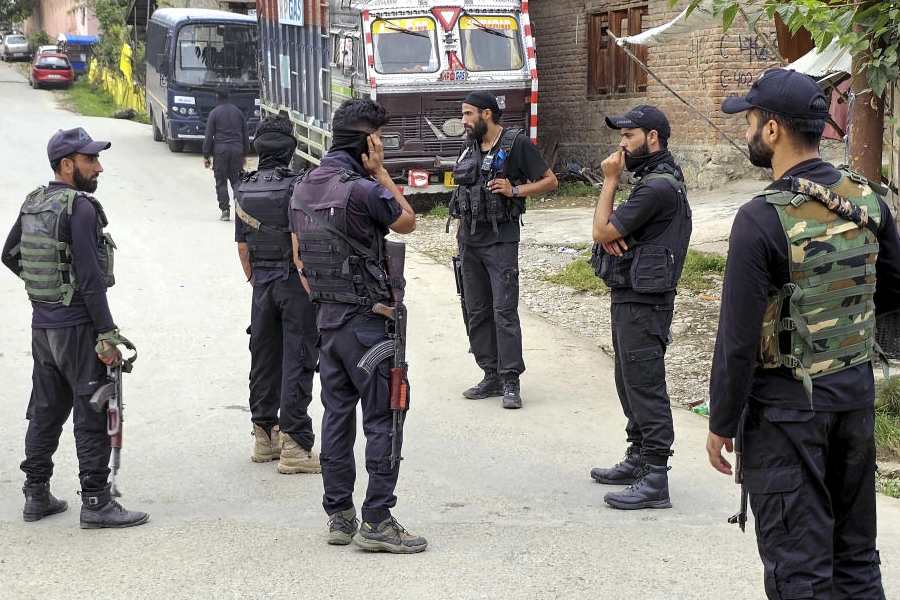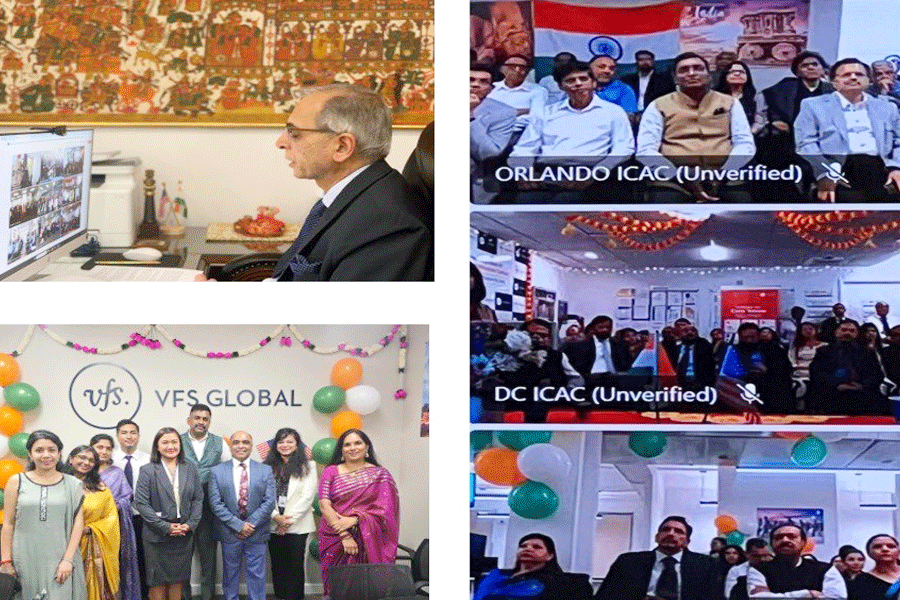 |
 |
 |
 |
| (From top): An astrologer at the Mannarsala Snake Temple; high priests carrying the Nagaraj idols; devotees at the complex; a sadhvin — all during the Ailyam festival |
Hidden between the lines of Kerala tourist brochures is another Kerala ? the ?real? one. It lies somewhere between the backwater cruises, the bikini-dotted beaches, the Ayurvedic treatments and the green valleys. It stays just out of sight, only sometimes glimpsed from the corner of your eye. But the traveller who ventures off the roads and walks down small leafy pathways will discover Kerala?s inner spaces and perchance his own.
It?s November, and just a half-hour away from our luxurious lakefront resort at Kumarakom in the foothills of the Western Ghats, the festival of Ailyam is being celebrated at the temple of Sri Nagaraj in Mannarsala. Ailyam, in the month of Tulam, fetes the miraculous birth of a mystical five-hooded serpent, born to an old woman long past the age of child-bearing.
A small motor boat speeds us to a tiny jetty 10 minutes away at Mohama, causing ripples in the glassy surface of the Vembanad Lake. From here, we drive through the crowded Alleppey township into the narrow twisting village roads of Haripad district.
We cross thousands of devotees, many of them barefoot, streaming back from the temple after darshan. Outside the temple courtyard is the Ailyam fair ? a sensory blitz of colour, clamour and smells. The path leading to the temple is lined with stalls selling bright slippers, gauzy fishing-nets in neon colours, shiny steel and copper pots, plastic toys, heaps of yellow pomelos and tender coconut. There are snake amulets and charms. An enterprising young hawker persuades people to buy tinted TV screens to change their black and white sets instantly and cheaply into colour sets. A vaid sits brewing his herbal oils in huge smoking vessels. There?s churanam, thailam and chyavanprasham to remedy every complaint ? from cancer to male impotence. Nearby a man sells Aloe Vera plants, the roots wrapped in white muslin.
Malayalis love gold, and everywhere the yellow metal gleams bright against burnished skin. Babies wear thick chains around their bare bottoms, the women are weighed down with several inches of it around their wrists. The men too wear a solid gold tabeez on a heavy chain around their necks; even the priests wear a thick gold rope down to their round bellies. The women are in bright silks or the traditional white and gold Kerala saree, their oiled kinky hair cascading in a mass of tiny curls and pinned with strings of tiny orange flowers. As we photograph the fair, the mild tropical winter sun lights everything with a molten glow, lending each frame the aura of an epic. We seem to be the only outsiders.
Outside the temple, women fortune-tellers sit under a tree whose roots shelter a number of snake images. For Rs 10 you may at random open a page in their book and they will interpret your destiny ? in Malayalam of course!
The Mannarsala family, who are the priests and caretakers of the temple, trace their lineage to the son of the woman who bore her child when she was long past bearing age, and it is believed that the mystical serpent Sri Nagaraj to which she gave birth first continues to live in the subterranean rooms beneath the temple. It reveals itself only to the high priestess, the eldest female member of the family.
According to the legend of Mannarsala, the old woman from the Namboodiri Brahmin community pleaded with the great Parasuram, the incarnation of Vishnu, for a son. Parasuram directed her plea to Vasuki, Lord of the Serpents, who adorns the neck of Shiva himself. Her prayer was heard. And in one of those bizarre quirks, so matter-of-factly assimilated in our myths, she gave birth first to the five-hooded chiranjivi (deathless) serpent and then to her sought-after son.
Snake shrines are traditionally built in groves or small forests, and the inner courtyard of the Sri Nagaraj temple seems like a living part of the huge trees that enfold it. In the centre of the courtyard is a large banyan, its roots smeared with turmeric and sheltering little oil lamps lit by devotees. Everywhere are thousands of small stone statues of serpents, placed over the years by those who?ve received favours from the snake deities. Despite the crush of people, the trees enclose a kind of hush and the leaves filter in a diffused dappled light. It is the simplest kind of worship. A reverential harmony with nature, and with the mystical serpents of the forest. For the tutored city mind, it is, strangely enough, a moment of deep restfulness. To suspend logic and judgement and be part of the obscure wisdom of an ancient rite. To lock your gaze with the deity in the moment of darshan, to sense and not understand.
Beneath our feet, the ground is clean, dry and sandy. In our hands are the five symbolic offerings. Turmeric, salt, a small snake-egg made of five metals, a small tin snake, and a tiny metal umbrella to symbolise the mud-hole home of the snake.
Suddenly the air is filled with high-pitched ululating. Amma is coming ? Uma Devi the high priestess of Mannarsala. She is a wizened bent old lady wrapped in a white saree still damp from the ritual bath she has just taken. She is followed in procession by priests holding aloft colourful silk umbrellas and ornate fans. A Nilavara Puja will be performed to Sri Nagaraj, the five-hooded serpent. Diyas are lit on an elaborate kollam made up of 64 snake motifs. Sri Nagaraj is benign and can be approached for deliverance from sarpadosha and rahudosha. For those who desire a child, the Urlikamartal Puja holds out hope. We meet a man, a chef at a luxury resort, who is there in thanksgiving for a child that was born to his wife after performing the urli-puja, nine months to the day! This after 14 years of a childless marriage. In the temple courtyard, stories fly like moths around the flame of faith ? tales of miracles, strange coincidences, inexplicable synchronicities. Pieces of a puzzle that gets more baffling even as the pieces fall into place. Reason enough to wander down to the ?other? Kerala and savour its mysteries and its miracles.
Photographs by Amit Pasricha
Plane speak
 |
When was the last time you had a relaxed flight? An incident-free affair minus any under-the-breath cussing, grumpy glaring or even a downright free-for-all squabble? Chances are you’re busting a brain cell trying to remember, right? That’s because most of us are guilty of being passengers of the self-involved sort, with nary a care for our fellow commuters. Yep, it’s a flyer-eat-flyer world up there!
Junaid Amin, a businessman recalls a recent exasperating flight on the London-Calcutta route. “There I was in a cramped economy seat for a good 13 hours and the entire time a robust behenji in front of me kept her seat reclined, even during meal time — despite polite requests for some room,” he says.
Like Junaid, almost every frequent flier has stories about the insensitive clod who shoves his seat back, causing food to fly off the tray table. Or alternatively, about the oaf sitting behind who keeps jamming his bony knees into the seat in front. Obviously the most mannerly thing for a traveller to do would be to check behind before going into recline mode. Also, you should try not to recline your seat all the way if it looks as though it’s going to make the person behind you uncomfortable. And ease the seat back slowly — you want to avoid spills and broken computer screens on the tray table at the back of your seat.
Jockeying for elbowroom is also a big problem faced by airline travellers. One solution is to divide the armrest in half width-wise. There also is another way that gives enough support for each elbow. All it needs is some clever division. Split the armrest into equal halves — front to back. One person places their elbow in the front half, pointing their arm diagonally in towards themselves. The other person takes control of the back half in the same manner. The result: ample room for both. But these work only if you have elbow-conscious neighbours! Otherwise you’re going to have to sit scrunched in your seat and just grin and bear it.
If you’re travelling with kids — you have our profound sympathies — it can take a long time for those nightmares to fade. If you and Lynette from Desperate Housewives are similar souls with similar brats, you need to rein in the monsters even more. Bribe them if you have to rather than allow them to run pell-mell down the aisles or have them kick the seats in front of them. If you find yourself on a plane with children, be patient. Most parents try to be considerate.
Says Rukhsana Eisa, a grooming and etiquette expert and also a flight attendant, “When other people’s kids are running amok during a flight, the best way to deal with the situation is refer it to one of the cabin crew. It’s less offensive this way. Parents are so into their children that they would find it insulting if directly reproached. Flight attendants are trained for this very thing. And people always react more positively to people in uniform.”
While new-age flying with its technological innovations can prove beneficial to the flyer, consider some of its fallouts. Like trying to avert your eyes from the pornographic film playing on the laptop of the passenger beside you.
And then there’s the issue of the guys who make suggestive remarks, seem to snuggle up too close when even in an economy seat there’s space to give you more room, those who seem to accidentally brush a little too close to you or even the gropers. Says Rukhsana, “Everyone is entitled to their space, especially since they’ve paid for it. And yes if he/she begins behaving badly purposely or passing lewd remarks, then it becomes a problem that again should be referred to the flight attendant on duty.”
And then there’s the whole breath issue. What to do when your seatmate clearly had a heavily laced garlic lunch — an odour that isn’t mixing so well with the tandoori chicken being downed by the guy on the other side of you. Again it falls into the category of grin and bear it.
What tends to top the poor etiquette list, however, is something almost all flyers have probably experienced: the person behind you stands up and grabs the back of your seat to balance. “There goes your nap,” says Shraddha Verma, an IT professional, who’s faced this problem “a hundred times”. The best policy to follow in this respect? Don’t hang onto a fellow passenger’s seat — lean on your own armrest instead. Maybe, the next time, he/she will return the favour and save you from that interrupted nap.
Other matters fall into the grey area. Taking off shoes to get more comfortable? That’s fine, as long as they don't reek. Climbing over a passenger in the middle of the night to go to the bathroom? Well, it can’t be helped, but either politely wake them up, or just manoeuvre your way past, hoping they aren’t disturbed? And as for shoving a dirty diaper into the seat pocket or handing it to the flight attendant, reading over a seatmate’s shoulder, hogging the bathroom or even repeatedly pressing on its door even though it’s occupied — all of these rank way up there on the list of strict no-nos.
These days, good manners often seem to be in short supply all around us — and even more so up in the air. But in today’s increasingly crowded skies, aeroplane etiquette is vital. Coexisting in the cramped confines of a plane would be a lot more pleasant — and safer — if we all observed a few simple rules. And follow that good old policy: do unto others as you would they do unto you.
Illustration by Suman Choudhury
My favourite holiday
 |
June,
actress
Earlier this year, I’d gone to Mcleodganj and spent 15 days there all by myself. The reason for my visit: to meet His Holiness, the Dalai Lama. It was an amazing experience. He held my hand and blessed me. For a practising Buddhist, this was a once-in-a-lifetime spiritual moment.
Whilst in Mcleodganj, I met a lot of people from across the world. The locals however, were even more interesting. I spent hours speaking to them about their feelings on being exiled from their motherland. What’s especially wonderful is how they have managed to preserve their rich heritage and culture in a foreign land.
Route map
• It’s an enticing two- or even three-in-one. Travel to Colombo, spend a few days in Sri Lanka and head on to another Eastern hotspot — all at rock-bottom rates with the airfares and hotels both thrown in. There are a handful of packages. While all packages (per person) offer two nights in Colombo, they offer two more nights to Singapore (Rs 13,060 + $125), Bangkok (Rs 12,060 + $105), Kuala Lumpur (Rs 13,060 + $125) and Hong Kong (Rs 15,830 + $150). The Hong Kong package is valid till August 31, others till October 31.
Longer packages throw in two nights in Colombo with three nights in Beijing (Rs 17,450 + $175), three nights in Male (Rs 14,680 + $375), two nights each in KL and Singapore (Rs 14,060 + $190), while a seven nights package includes two nights each in KL and Singapore and another in Genting Highlands (Rs 14,060 + $215). A five nights package has two nights in KL and another in Genting Highlands (Rs 13,060 + $150). With airfare, accommodation, breakfast and airport transfers taken care of, just take shopping money along. If you’re wondering how much you can save on these packages, remember that the Delhi-Colombo-Delhi fare is around Rs 16,000.
• Myanmar Airways has come out with a return fare to Bangkok and Yangon for Rs 6,999 and Rs 6,499, respectively, from New Delhi. The offer, valid till August 31, takes almost 50 per cent off its regular fares on these routes. The Yangon-Bangkok leg is flown on Thai Airways, with attractive packages thrown in. The offer comes with some riders like a no-refund clause and restrictions in date-flight changes. South-East Asian routes have seen a steady drop in fares over the last month. Thai Airways recently cut its Bangkok fares from Delhi by around 20 per cent. Another round of fare cuts in the South -East Asian routes is expected in August to woo incentive tour travellers and students.










